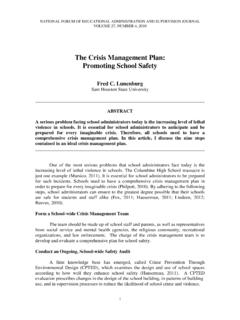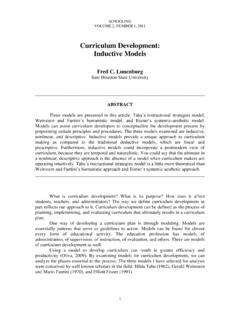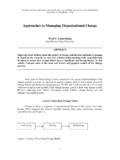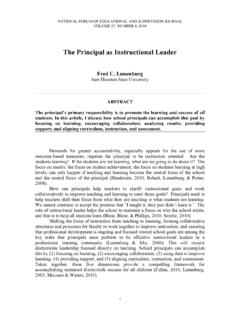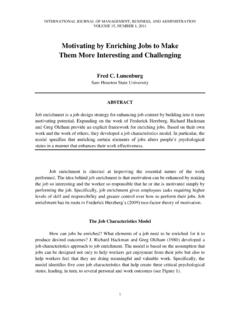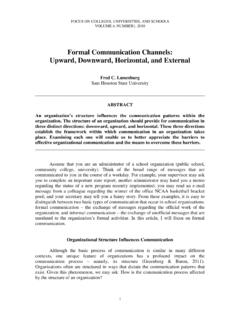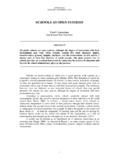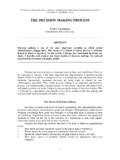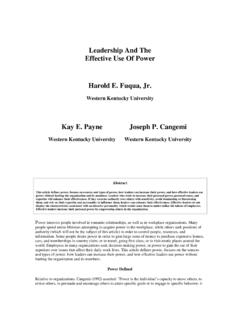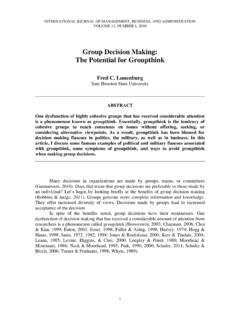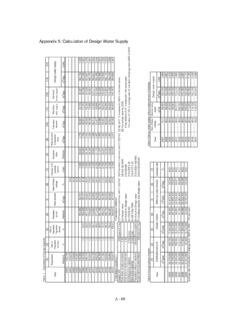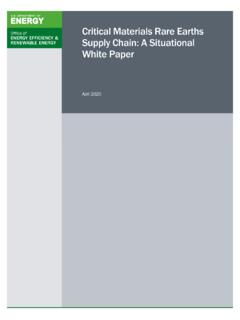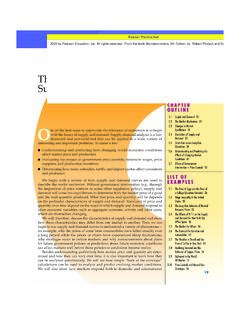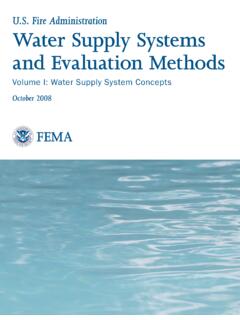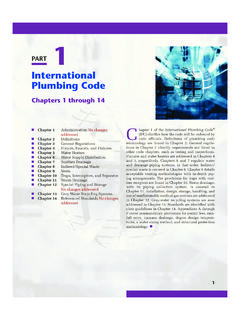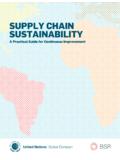Transcription of Human Resource Planning: Forecasting Demand and Supply
1 INTERNATIONAL JOURNAL OF MANAGEMENT, BUSINESS, AND ADMINISTRATION VOLUME 15, NUMBER 1, 2012 1 Human Resource Planning: Forecasting Demand and Supply Fred C. Lunenburg Sam Houston State University _____ Abstract Human Resource planning begins with a forecast of the number and types of employees needed to achieve the organization s objectives. Planning also involves job analysis, which consists of the preparation of job descriptions and job specifications. Of particular concern for today s executives is the growing body of laws regulating the Human Resource management process.
2 _____ Human Resource Management Process The overall Human Resource management process comprises the following programs: Human Resource planning, recruitment, selection, professional development, performance appraisal, and compensation. In this article, I examine one of the Human Resource management processes ( Human Resource planning), because it is such an important function that is often neglected. The planning function, in general, involves defining an organization s goals, establishing a strategy for achieving those goals, and developing a comprehensive set of plans to integrate and coordinate activities (Robbins & Judge, 2013).
3 The necessity of this function follows from the nature of organizations as purposive (goal-seeking) entities (Gibson, Ivancevich, Donnelly, & Konopaske, 2012). Planning activities can be complex or simple, implicit or explicit, impersonal or personal. For example, a Human Resource manager Forecasting Demand for the firm s Human resources may rely on complex econometric models or casual conversation with Human Resource personnel in the field. Good Human Resource planning involves meeting current and future personnel needs.
4 The manager ensures that personnel needs are met through ongoing analysis of performance objectives, job requirements, and available personnel, coupled with knowledge of employment laws. INTERNATIONAL JOURNAL OF MANAGEMENT, BUSINESS, AND ADMINISTRATION 2_____ Human Resource Planning Organizations typically plan their future needs for supplies, equipment, building capacity, and financing. Organizations must also plan to ensure that their Human Resource needs are satisfied. Human Resource planning involves identifying staffing needs, Forecasting available personnel, and determining what additions or replacements are required to maintain a staff of the desired quantity and quality to achieve the organization s goals.
5 The Human Resource planning function involves at least three different elements: job analysis, Forecasting Demand and Supply , and legal restraints. Job Analysis Company president, manager, director of personnel, legal counsel, labor relations specialist, college president, dean, and professor are all jobs. To recruit and select the appropriate personnel for specific jobs, it is necessary to know what the jobs entail. Job analysis is the process of obtaining information about jobs through a systematic examination of job content ( Department of Labor, 2012).
6 A job analysis usually consists of two parts: a job description and a job specification. The job description is a written statement that outlines the duties and responsibilities expected of a job incumbent. It usually includes a job title, the title of the incumbent s immediate supervisor, a brief statement of the job goal, and a list of duties and responsibilities. The job specification is a written document that outlines the qualifications that a person needs in order to accomplish the duties and responsibilities set forth in the job description.
7 Job analysis provides valuable information for Forecasting future staffing needs and other personnel management functions. For example, the data produced by the job analysis can be used to develop appropriate recruitment and selection methods to determine dimensions on which personnel should be evaluated, to determine the worth of jobs for compensation purposes, and to develop training programs for personnel. Job analysis techniques. A variety of techniques are available for conducting a job analysis. The technique most appropriate for a given situation depends on a number of factors, such as the type of job being analyzed, the resources available for doing a job analysis, the scope of the job, and the size of the organization.
8 Some of the most commonly used techniques for conducting a job analysis include observation, work sampling, critical incidents, interviews, and questionnaires. Observation. The most straightforward method of job analysis is observation of people performing the job. Observation can be a good way of examining jobs that consist mainly of observable physical activity. Jobs such as maintenance worker, groundskeeper, and machine operator are examples. Analyzing a job through observation is not appropriate where the job requires much abstract thinking, planning, or decision making ( , company president, labor relations specialist, legal counsel).
9 FRED C. LUNENBURG _____3 Work sampling. A variation of the observation technique is the work sampling approach. The job analyst periodically samples employees activities and behavior on jobs that have long cycles, that have irregular patterns of activity, or that require a variety of different tasks. For example, research on the administrative demands of department heads consistently shows that they are fragmented and rapid fire. A personnel administrator could examine the job activities of twenty-five or thirty company executives on a given day or randomly select twenty-five or thirty days of the year and observe the job activities of five executives during those days.
10 This approach is similar to the one used by Henry Mintzberg (1998) when he undertook a careful study of five executives to determine what they did on their jobs. On the basis of his observations, Mintzberg concluded that company executives perform ten different, highly interrelated roles, which he divided into three categories: figurehead, leader, liaison (interpersonal); monitor, disseminator, spokesperson, decisional (informational); and entrepreneur, disturbance handler, Resource allocator, negotiator (decisional).
